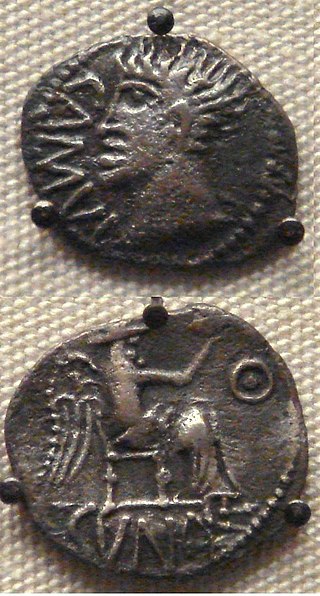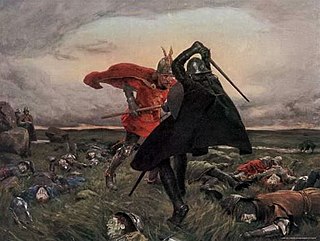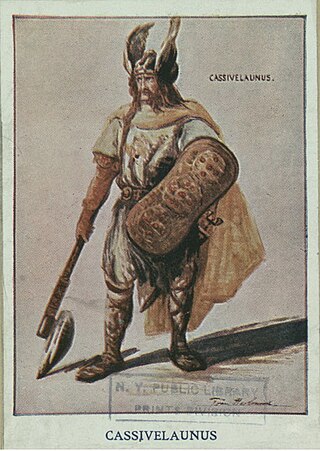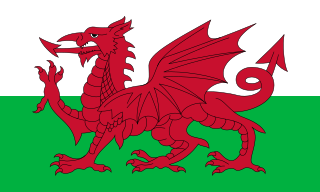Related Research Articles

Geoffrey of Monmouth was a Catholic cleric from Monmouth, Wales, and one of the major figures in the development of British historiography and the popularity of tales of King Arthur. He is best known for his chronicle The History of the Kings of Britain which was widely popular in its day, being translated into other languages from its original Latin. It was given historical credence well into the 16th century, but is now considered historically unreliable.
Afallach is a man's name found in several medieval Welsh genealogies, where he is made the son of Beli Mawr. According to a medieval Welsh triad, Afallach was the father of the goddess Modron. The Welsh redactions of Geoffrey of Monmouth's Historia Regum Britanniae, Brut y Brenhinedd, associate him with Ynys Afallach, which is substituted as the Welsh name for Geoffrey's Insula Avalonsis, but this is fanciful medieval etymology and it is more likely his name derives from the Welsh word afall "apple tree" ; from which, granted, the name of Avalon is also often thought to derive, so that the meaning of "Afallach" is associated but not necessarily directly. In the tale of Urien and Modron he is referred to by his daughter as the King of Annwn, therefore he may originally been cognate with Arawn or Gwyn or perhaps all three were once regional variants of the same Deity.

Lud, according to Geoffrey of Monmouth's pseudohistorical History of the Kings of Britain and related medieval texts, was a king of Britain in pre-Roman times who founded London and was buried at Ludgate. He was the eldest son of Geoffrey's King Heli, and succeeded his father to the throne. He was succeeded, in turn, by his brother Cassibelanus. Lud may be connected with the Welsh mythological figure Lludd Llaw Eraint, earlier Nudd Llaw Eraint, cognate with the Irish Nuada Airgetlám, a king of the Tuatha Dé Danann, and the Brittonic god Nodens. However, he was a separate figure in Welsh tradition and is usually treated as such.

Beli Mawr was an ancestor figure in Middle Welsh literature and genealogies. He is the father of Cassivellaunus, Arianrhod, Lludd Llaw Eraint, Llefelys, and Afallach. In certain medieval genealogies, he is listed as the son or husband of Anna, cousin of Mary, mother of Jesus. According to the Welsh Triads, Beli and Dôn were the parents of Arianrhod, but the mother of Beli's other children—and the father of Dôn's other children—is not mentioned in the medieval Welsh literature. Several royal lines in medieval Wales traced their ancestry to Beli. The Mabinogi names Penarddun as a daughter of Beli Mawr, but the genealogy is confused; it is possible she was meant to be his sister rather than daughter.

Cunobeline or Cunobelin, also known by his name's Latin form Cunobelinus, was a king in pre-Roman Britain from about AD 9 to about AD 40. He is mentioned in passing by the classical historians Suetonius and Dio Cassius, and many coins bearing his inscription have been found. He controlled a substantial portion of south-eastern Britain, including the territories of the Catuvellauni and the Trinovantes, and is called "King of the Britons" by Suetonius. Cunobeline may have been a client king of Rome, based on the images and legends appearing on his coins. Cunobeline appears in British legend as Cynfelyn (Welsh), Kymbelinus or Cymbeline, as in the play by William Shakespeare.

King Lot, also spelled Loth or Lott, is a British monarch in Arthurian legend. He was introduced in Geoffrey of Monmouth's pseudohistorical Historia Regum Britanniae as King Arthur's brother-in-law, who serves as regent of Britain between the reigns of Uther Pendragon and Arthur. He has appeared regularly in works of chivalric romance, alternating between the roles of Arthur's enemy and ally, and is often depicted as the ruler of Lothian and either Norway or Orkney. His literary character is probably derived from hagiographical material concerning Saint Kentigern, which features Leudonus as king of Leudonia and father of Saint Teneu.

The Battle of Camlann is the legendary final battle of King Arthur, in which Arthur either died or was mortally wounded while fighting either alongside or against Mordred, who also perished. The original legend of Camlann, inspired by a purportedly historical event said to have taken place in the early 6th-century Britain, is only vaguely described in several medieval Welsh texts dating from around the 10th century. The battle's much more detailed depictions have emerged since the 12th century, generally based on that of a catastrophic conflict described in the pseudo-chronicle Historia Regum Britanniae. The further greatly embellished variants originate from the later French chivalric romance tradition, in which it became known as the Battle of Salisbury, and include the 15th-century telling in Le Morte d'Arthur that remains popular today.

Tasciovanus was a historical king of the Catuvellauni tribe before the Roman conquest of Britain.

Cassivellaunus was a historical British military leader who led the defence against Julius Caesar's second expedition to Britain in 54 BC. He led an alliance of tribes against Roman forces, but eventually surrendered after his location was revealed to Julius Caesar by defeated Britons.
Catellus was a legendary king of the Britons, as recounted in Geoffrey of Monmouth's work Historia Regum Britanniae. He came to power in 269 BC.
Digueillus was a legendary king of the Brythons according to Geoffrey of Monmouth. He was the son of King Capoir and succeeded by his son Heli. He came to power in 113BC.
Nennius is a mythical prince of Britain at the time of Julius Caesar's invasions of Britain. His story appears in Geoffrey of Monmouth's History of the Kings of Britain (1136), a work whose contents are now considered largely fictional. In Middle Welsh versions of Geoffrey's Historia he was called Nynniaw.

Welsh mythology consists of both folk traditions developed in Wales, and traditions developed by the Celtic Britons elsewhere before the end of the first millennium. As in most of the predominantly oral societies Celtic mythology and history were recorded orally by specialists such as druids. This oral record has been lost or altered as a result of outside contact and invasion over the years. Much of this altered mythology and history is preserved in medieval Welsh manuscripts, which include the Red Book of Hergest, the White Book of Rhydderch, the Book of Aneirin and the Book of Taliesin. Other works connected to Welsh mythology include the ninth-century Latin historical compilation Historia Brittonum and Geoffrey of Monmouth's twelfth-century Latin chronicle Historia Regum Britanniae, as well as later folklore, such as the materials collected in The Welsh Fairy Book by William Jenkyn Thomas (1908).
Lludd Llaw Ereint, "Lludd of the Silver Hand", son of Beli Mawr, is a legendary hero from Welsh mythology. As Nudd Llaw Ereint he is the father of Gwyn ap Nudd. He is probably the source of king Lud from Geoffrey of Monmouth's History of the Kings of Britain.
The Battle of Chester was a major victory for the Anglo-Saxons over the native Britons near the city of Chester, England in the early 7th century. Æthelfrith of Northumbria annihilated a combined force from the Welsh kingdoms of Powys and Rhôs, and possibly from Mercia as well. It resulted in the deaths of Welsh leaders Selyf Sarffgadau of Powys and Cadwal Crysban of Rhôs. Circumstantial evidence suggests that King Iago of Gwynedd may have also been killed. Other sources state the battle may have been in 613 or even as early as 607 or 605 AD.
The Coraniaid are a race of beings from Welsh mythology. They appear in the Middle Welsh prose tale Lludd and Llefelys, which survives in the Mabinogion and inserted into several texts of the Brut y Brenhinedd, a Welsh adaptation of Geoffrey of Monmouth's Historia Regum Britanniae. The Coraniaid figure in the tale as one of three plagues that affect Britain during the reign of King Lludd. They are characterized by a sense of hearing so acute that they can hear any word the wind touches, making action against them impossible.

Brut y Brenhinedd is a collection of variant Middle Welsh versions of Geoffrey of Monmouth's Latin Historia Regum Britanniae. About 60 versions survive, with the earliest dating to the mid-13th century. Adaptations of Geoffrey's Historia were extremely popular throughout Western Europe during the Middle Ages, but the Brut proved especially influential in medieval Wales, where it was largely regarded as an accurate account of the early history of the Celtic Britons.

Lludd and Llefelys is a Middle Welsh prose tale written down in the 12th or 13th century; it was included in the Mabinogion by Lady Charlotte Guest in the 19th century. It tells of the Welsh hero Lludd Llaw Eraint, best known as King Lud son of Heli in Geoffrey of Monmouth's Historia Regum Britanniae, and his brother Llefelys.
Walter of Oxford was a cleric and writer. He served as archdeacon of Oxford in the 12th century. Walter was a friend of Geoffrey of Monmouth, who claimed he got his chief source for the Historia Regum Britanniae from Walter.
A number of medieval chronicles of the history of Wales survive, notably the 9th century Historia Brittonum and the 10th century Annales Cambriae. These early chronicles are written in Latin, while from the 12th century, some are composed in Middle Welsh. The oldest surviving manuscripts of chronicles kept in the National Library of Wales, Aberystwyth date to the 13th century.
References
- ↑ Sterckx, Claude, "Nûtons, Lûtons et dieux celtes", Zeitschrift für celtische Philologie, Vol.46, pp. 39–79
- ↑ Houck, Margaret Evah. Sources of the Roman de Brut of Wace, R. West, 1977, p. 16; p. 43.
- ↑ Bartrum, Peter. A Welsh Classical Dictionary, National Library of Wales, 1993, p. 131; pp. 416–418; p. 491-492.
- ↑ Roberts, Brynley F. "The Treatment of Personal Names in the Early Welsh Versions of the Historia Regum Britanniae." Bulletin of the Board of Celtic Studies 25 (1973): 274–90.
- ↑ Hutson, Arthur Eugene. British personal names in the Historia regum Britanniae, Volume 5, University of California Press, 1940, p. 43.
- ↑ Houck, Margaret Evah. Sources of the Roman de Brut of Wace, R. West, 1977, p. 16.
- ↑ Curley, Michael J., Geoffrey of Monmouth, Cengage Gale, 1994, p. 24.
- 1 2 Koch, John T. (2006). Celtic Culture: A Historical Encyclopedia. ABC-CLIO. pp. 1164–1165. ISBN 1-85109-440-7.
- ↑ Koch, John T. (2006). Celtic Culture: A Historical Encyclopedia. ABC-CLIO. pp. 1359–1361. ISBN 1-85109-440-7.
- ↑ Bartrum, Peter. A Welsh Classical Dictionary, National Library of Wales, 1993, p. 417.